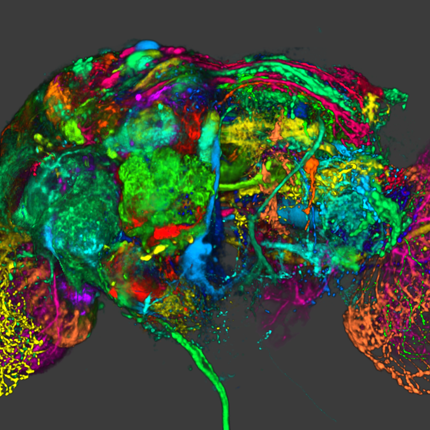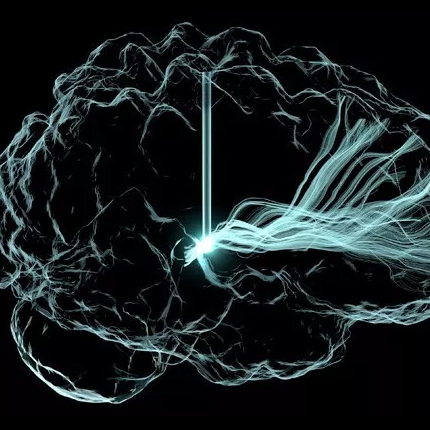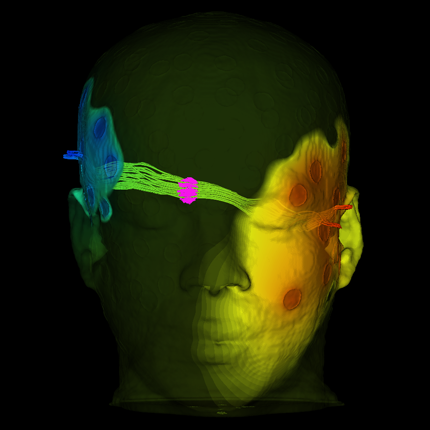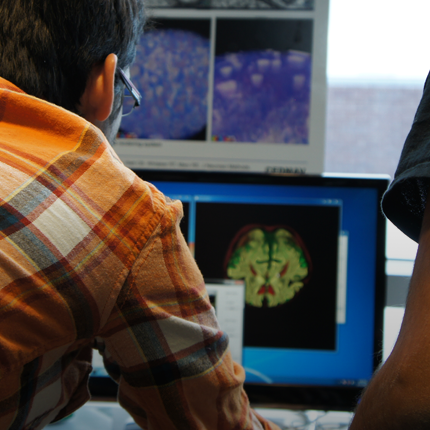Biomedical Computing
Biomedical computing combines the diagnostic and investigative aspects of biology and medical science with the power and problem-solving capabilities of modern computing. Computers are used to accelerate research learning, simulate patient behavior and visualize complex biological models.
Jeff Weiss
Computational Biomechanics
Orly Alter
Computational Biology
Tamara Bidone
Computational Models
Simulations of Biological Systems
Multi-Physics Models of Cancer Cells
Centers and Labs:
- Center for Integrative Biomedical Computing
- Muskuloskeletal Research Laboratory
- Genomic Signal Processing Lab
- Computational Biomechanics Group
Funded Research Projects:
Publications in Biomedical Computing:
  Fabrication of dense anisotropic collagen scaffolds using biaxial compression J.L. Zitnay, S.P. Reese, G. Tran, N. Farhang, R.D. Bowles, J.A. Weiss. In Acta Biomaterialia, Vol. 65, Elsevier BV, pp. 76--87. Jan, 2018. DOI: 10.1016/j.actbio.2017.11.017 We developed a new method to manufacture dense, aligned, and porous collagen scaffolds using biaxial plastic compression of type I collagen gels. Using a novel compression apparatus that constricts like an iris diaphragm, low density collagen gels were compressed to yield a permanently densified, highly aligned collagen material. Micro-porosity scaffolds were created using hydrophilic elastomer porogens that can be selectively removed following biaxial compression, with porosity modulated by using different porogen concentrations. The resulting scaffolds exhibit collagen densities that are similar to native connective tissues (∼10% collagen by weight), pronounced collagen alignment across multiple length scales, and an interconnected network of pores, making them highly relevant for use in tissue culture, the study of physiologically relevant cell-matrix interactions, and tissue engineering applications. The scaffolds exhibited highly anisotropic material behavior, with the modulus of the scaffolds in the fiber direction over 100 times greater than the modulus in the transverse direction. Adipose-derived mesenchymal stem cells were seeded onto the biaxially compressed scaffolds with minimal cell death over seven days of culture, along with cell proliferation and migration into the pore spaces. This fabrication method provides new capabilities to manufacture structurally and mechanically relevant cytocompatible scaffolds that will enable more physiologically relevant cell culture studies. Further improvement of manufacturing techniques has the potential to produce engineered scaffolds for direct replacement of dense connective tissues such as meniscus and annulus fibrosus. |
  PFEIFER: Preprocessing Framework for Electrograms Intermittently Fiducialized from Experimental Recordings A. Rodenhauser, W.W. Good, B. Zenger, J. Tate, K. Aras, B. Burton, R.S. Macleod. In The Journal of Open Source Software, Vol. 3, No. 21, The Open Journal, pp. 472. Jan, 2018. DOI: 10.21105/joss.00472 Preprocessing Framework for Electrograms Intermittently Fiducialized from Experimental Recordings (PFEIFER) is a MATLAB Graphical User Interface designed to process bioelectric signals acquired from experiments. |
 Finite Element Framework for Computational Fluid Dynamics in FEBio, G.A. Ateshian, J.J. Shim, S.A. Maas, J.A. Weiss. In Journal of Biomechanical Engineering, Vol. 140, No. 2, ASME International, pp. 021001. Jan, 2018. DOI: 10.1115/1.4038716 The mechanics of biological fluids is an important topic in biomechanics, often requiring the use of computational tools to analyze problems with realistic geometries and material properties. This study describes the formulation and implementation of a finite element framework for computational fluid dynamics (CFD) in FEBio, a free software designed to meet the computational needs of the biomechanics and biophysics communities. This formulation models nearly incompressible flow with a compressible isothermal formulation that uses a physically realistic value for the fluid bulk modulus. It employs fluid velocity and dilatation as essential variables: The virtual work integral enforces the balance of linear momentum and the kinematic constraint between fluid velocity and dilatation, while fluid density varies with dilatation as prescribed by the axiom of mass balance. Using this approach, equal-order interpolations may be used for both essential variables over each element, contrary to traditional mixed formulations that must explicitly satisfy the inf-sup condition. The formulation accommodates Newtonian and non-Newtonian viscous responses as well as inviscid fluids. The efficiency of numerical solutions is enhanced using Broyden's quasi-Newton method. The results of finite element simulations were verified using well-documented benchmark problems as well as comparisons with other free and commercial codes. These analyses demonstrated that the novel formulation introduced in FEBio could successfully reproduce the results of other codes. The analogy between this CFD formulation and standard finite element formulations for solid mechanics makes it suitable for future extension to fluid–structure interactions (FSIs). |
  Perspectives on Sharing Models and Related Resources in Computational Biomechanics Research A. Erdemir, P.J. Hunter, G.A. Holzapfel, L.M. Loew, J. Middleton, C.R. Jacobs, P. Nithiarasu, R. Löhner, G. Wei, B.A. Winkelstein, V.H. Barocas, F. Guilak, J.P. Ku, J.L. Hicks, S.L. Delp, M.S. Sacks, J.A. Weiss, G.A. Ateshian, S.A. Maas, A.D. McCulloch, G.C.Y. Peng. In Journal of Biomechanical Engineering, Vol. 140, No. 2, ASME International, pp. 024701. Jan, 2018. DOI: 10.1115/1.4038768 The role of computational modeling for biomechanics research and related clinical care will be increasingly prominent. The biomechanics community has been developing computational models routinely for exploration of the mechanics and mechanobiology of diverse biological structures. As a result, a large array of models, data, and discipline-specific simulation software has emerged to support endeavors in computational biomechanics. Sharing computational models and related data and simulation software has first become a utilitarian interest, and now, it is a necessity. Exchange of models, in support of knowledge exchange provided by scholarly publishing, has important implications. Specifically, model sharing can facilitate assessment of reproducibility in computational biomechanics and can provide an opportunity for repurposing and reuse, and a venue for medical training. The community's desire to investigate biological and biomechanical phenomena crossing multiple systems, scales, and physical domains, also motivates sharing of modeling resources as blending of models developed by domain experts will be a required step for comprehensive simulation studies as well as the enhancement of their rigor and reproducibility. The goal of this paper is to understand current perspectives in the biomechanics community for the sharing of computational models and related resources. Opinions on opportunities, challenges, and pathways to model sharing, particularly as part of the scholarly publishing workflow, were sought. A group of journal editors and a handful of investigators active in computational biomechanics were approached to collect short opinion pieces as a part of a larger effort of the IEEE EMBS Computational Biology and the Physiome Technical Committee to address model reproducibility through publications. A synthesis of these opinion pieces indicates that the community recognizes the necessity and usefulness of model sharing. There is a strong will to facilitate model sharing, and there are corresponding initiatives by the scientific journals. Outside the publishing enterprise, infrastructure to facilitate model sharing in biomechanics exists, and simulation software developers are interested in accommodating the community's needs for sharing of modeling resources. Encouragement for the use of standardized markups, concerns related to quality assurance, acknowledgement of increased burden, and importance of stewardship of resources are noted. In the short-term, it is advisable that the community builds upon recent strategies and experiments with new pathways for continued demonstration of model sharing, its promotion, and its utility. Nonetheless, the need for a long-term strategy to unify approaches in sharing computational models and related resources is acknowledged. Development of a sustainable platform supported by a culture of open model sharing will likely evolve through continued and inclusive discussions bringing all stakeholders at the table, e.g., by possibly establishing a consortium. |
 Isolated focal cartilage and labral defects in patients with femoroacetabular impingement syndrome may represent new, unique injury patterns, A.L. Kapron, S.K. Aoki, J.A. Weiss, A.J. Krych, T.G. Maak. In Knee Surgery, Sports Traumatology, Arthroscopy, Springer Nature, Feb, 2018. DOI: 10.1007/s00167-018-4861-2 Purpose |
  Hip chondrolabral mechanics during activities of daily living: Role of the labrum and interstitial fluid pressurization J.N. Todd, T.G. Maak, G.A. Ateshian, S.A. Maas, J.A. Weiss. In Journal of Biomechanics, Vol. 69, Elsevier BV, pp. 113--120. March, 2018. DOI: 10.1016/j.jbiomech.2018.01.001 Osteoarthritis of the hip can result from mechanical factors, which can be studied using finite element (FE) analysis. FE studies of the hip often assume there is no significant loss of fluid pressurization in the articular cartilage during simulated activities and approximate the material as incompressible and elastic. This study examined the conditions under which interstitial fluid load support remains sustained during physiological motions, as well as the role of the labrum in maintaining fluid load support and the effect of its presence on the solid phase of the surrounding cartilage. We found that dynamic motions of gait and squatting maintained consistent fluid load support between cycles, while static single-leg stance experienced slight fluid depressurization with significant reduction of solid phase stress and strain. Presence of the labrum did not significantly influence fluid load support within the articular cartilage, but prevented deformation at the cartilage edge, leading to lower stress and strain conditions in the cartilage. A morphologically accurate representation of collagen fibril orientation through the thickness of the articular cartilage was not necessary to predict fluid load support. However, comparison with simplified fibril reinforcement underscored the physiological importance. The results of this study demonstrate that an elastic incompressible material approximation is reasonable for modeling a limited number of cyclic motions of gait and squatting without significant loss of accuracy, but is not appropriate for static motions or numerous repeated motions. Additionally, effects seen from removal of the labrum motivate evaluation of labral reattachment strategies in the context of labral repair. |
  P1125 Noninvasive localization of premature ventricular complexes: a research-community-based approach M.J.M. Cluitmans, S. Ghimire, J. Dhamala, J. Coll-Font, J.D. Tate, S. Giffard-Roisin, J. Svehlikova, O. Doessel, M.S. Guillem, D.H. Brooks, R.S. Macleod, L. Wang. In EP Europace, Vol. 20, No. Supplement, Oxford University Press, March, 2018. DOI: 10.1093/europace/euy015.611 Background: Noninvasive localization of premature ventricular complexes (PVCs) to guide ablation therapy is one of the emerging applications of electrocardiographic imaging (ECGI). Because of its increasing clinical use, it is essential to compare the many implementations of ECGI that exist to understand the specific characteristics of each approach. |
  Image-Based Modeling of Acute Myocardial Ischemia Using Experimentally Derived Ischemic Zone Source Representations B.M. Burton, K.K. Aras, W.W. Good, J.D. Tate, B. Zenger, R.S. MacLeod. In Journal of Electrocardiology, Vol. 51, No. 4, Elsevier BV, pp. 725--733. July, 2018. DOI: 10.1016/j.jelectrocard.2018.05.005 Background |
  Higher contact force during radiofrequency ablation leads to a much larger increase in edema as compared to chronic lesion size S. Thomas, J. Silvernagel, N. Angel, E. Kholmovski, E. Ghafoori, N. Hu, J. Ashton, D.J. Dosdall, R.S. MacLeod, R. Ranjan. In Journal of Cardiovascular Electrophysiology, Wiley, June, 2018. DOI: 10.1111/jce.13636 1 Introduction |
  A Framework for Image-Based Modeling of Acute Myocardial Ischemia Using Intramurally Recorded Extracellular Potentials B.M. Burton, K.K. Aras, W.W. Good, J.D. Tate, B. Zenger, R.S. MacLeod. In Annals of Biomedical Engineering, Springer Nature, May, 2018. DOI: 10.1007/s10439-018-2048-0 The biophysical basis for electrocardiographic evaluation of myocardial ischemia stems from the notion that ischemic tissues develop, with relative uniformity, along the endocardial aspects of the heart. These injured regions of subendocardial tissue give rise to intramural currents that lead to ST segment deflections within electrocardiogram (ECG) recordings. The concept of subendocardial ischemic regions is often used in clinical practice, providing a simple and intuitive description of ischemic injury; however, such a model grossly oversimplifies the presentation of ischemic disease—inadvertently leading to errors in ECG-based diagnoses. Furthermore, recent experimental studies have brought into question the subendocardial ischemia paradigm suggesting instead a more distributed pattern of tissue injury. These findings come from experiments and so have both the impact and the limitations of measurements from living organisms. Computer models have often been employed to overcome the constraints of experimental approaches and have a robust history in cardiac simulation. To this end, we have developed a computational simulation framework aimed at elucidating the effects of ischemia on measurable cardiac potentials. To validate our framework, we simulated, visualized, and analyzed 226 experimentally derived acute myocardial ischemic events. Simulation outcomes agreed both qualitatively (feature comparison) and quantitatively (correlation, average error, and significance) with experimentally obtained epicardial measurements, particularly under conditions of elevated ischemic stress. Our simulation framework introduces a novel approach to incorporating subject-specific, geometric models and experimental results that are highly resolved in space and time into computational models. We propose this framework as a means to advance the understanding of the underlying mechanisms of ischemic disease while simultaneously putting in place the computational infrastructure necessary to study and improve ischemia models aimed at reducing diagnostic errors in the clinic. |
  Computationally optimized ECoG stimulation with local safety constraints S. Guler, M. Dannhauer, B. Roig-Solvas, A. Gkogkidis, R. Macleod, T. Ball, J. G. Ojemann, D. H. Brooks. In NeuroImage, Vol. 173, Elsevier BV, pp. 35--48. June, 2018. DOI: 10.1016/j.neuroimage.2018.01.088 Direct stimulation of the cortical surface is used clinically for cortical mapping and modulation of local activity. Future applications of cortical modulation and brain-computer interfaces may also use cortical stimulation methods. One common method to deliver current is through electrocorticography (ECoG) stimulation in which a dense array of electrodes are placed subdurally or epidurally to stimulate the cortex. However, proximity to cortical tissue limits the amount of current that can be delivered safely. It may be desirable to deliver higher current to a specific local region of interest (ROI) while limiting current to other local areas more stringently than is guaranteed by global safety limits. Two commonly used global safety constraints bound the total injected current and individual electrode currents. However, these two sets of constraints may not be sufficient to prevent high current density locally (hot-spots). In this work, we propose an efficient approach that prevents current density hot-spots in the entire brain while optimizing ECoG stimulus patterns for targeted stimulation. Specifically, we maximize the current along a particular desired directional field in the ROI while respecting three safety constraints: one on the total injected current, one on individual electrode currents, and the third on the local current density magnitude in the brain. This third set of constraints creates a computational barrier due to the huge number of constraints needed to bound the current density at every point in the entire brain. We overcome this barrier by adopting an efficient two-step approach. In the first step, the proposed method identifies the safe brain region, which cannot contain any hot-spots solely based on the global bounds on total injected current and individual electrode currents. In the second step, the proposed algorithm iteratively adjusts the stimulus pattern to arrive at a solution that exhibits no hot-spots in the remaining brain. We report on simulations on a realistic finite element (FE) head model with five anatomical ROIs and two desired directional fields. We also report on the effect of ROI depth and desired directional field on the focality of the stimulation. Finally, we provide an analysis of optimization runtime as a function of different safety and modeling parameters. Our results suggest that optimized stimulus patterns tend to differ from those used in clinical practice. |
  Research and Education in Computational Science and Engineering U. Ruede, K. Willcox, L. C. McInnes, H. De Sterck, G. Biros, H. Bungartz, J. Corones, E. Cramer, J. Crowley, O. Ghattas, M. Gunzburger, M. Hanke, R. Harrison, M. Heroux, J. Hesthaven, P. Jimack, C. Johnson, K. E. Jordan, D. E. Keyes, R. Krause, V. Kumar, S. Mayer, J. Meza, K. M. Mrken, J. T. Oden, L. Petzold, P. Raghavan, S. M. Shontz, A. Trefethen, P. Turner, V. Voevodin, B. Wohlmuth,, C. S. Woodward. In SIAM Review, Vol. 60, No. 3, SIAM, pp. 707--754. Jan, 2018. DOI: 10.1137/16m1096840 This report presents challenges, opportunities and directions for computational science and engineering (CSE) research and education for the next decade. Over the past two decades the field of CSE has penetrated both basic and applied research in academia, industry, and laboratories to advance discovery, optimize systems, support decision-makers, and educate the scientific and engineering workforce. Informed by centuries of theory and experiment, CSE performs computational experiments to answer questions that neither theory nor experiment alone is equipped to answer. CSE provides scientists and engineers with algorithmic inventions and software systems that transcend disciplines and scales. CSE brings the power of parallelism to bear on troves of data. Mathematics-based advanced computing has become a prevalent means of discovery and innovation in essentially all areas of science, engineering, technology, and society; and the CSE community is at the core of this transformation. However, a combination of disruptive developments—including the architectural complexity of extreme-scale computing, the data revolution and increased attention to data-driven discovery, and the specialization required to follow the applications to new frontiers—is redefining the scope and reach of the CSE endeavor. With these many current and expanding opportunities for the CSE field, there is a growing demand for CSE graduates and a need to expand CSE educational offerings. This need includes CSE programs at both the undergraduate and graduate levels, as well as continuing education and professional development programs, exploiting the synergy between computational science and data science. Yet, as institutions consider new and evolving educational programs, it is essential to consider the broader research challenges and opportunities that provide the context for CSE education and workforce development. |
  Characterization of Gadolinium Contrast Enhancement of Radiofrequency Ablation Lesions in Predicting Edema and Chronic Lesion Size E. Ghafoori, E.G. Kholmovski, S. Thomas, J. Silvernagel, N. Angel, N. Hu, D.J. Dosdall, R.s. MacLeod, R. Ranjan. In Circulation: Arrhythmia and Electrophysiology, Vol. 10, No. 11, Ovid Technologies (Wolters Kluwer Health), pp. e005599. Oct, 2017. DOI: 10.1161/circep.117.005599 Background Magnetic resonance imaging (MRI) has been used to acutely visualize radiofrequency ablation lesions, but its accuracy in predicting chronic lesion size is unknown. The main goal of this study was to characterize different areas of enhancement in late gadolinium enhancement MRI done immediately after ablation to predict acute edema and chronic lesion size. |
  Pedunculopontine nucleus deep brain stimulation in Parkinson's disease: A clinical review W.Thevathasan, B. Debu, T. Aziz, B. R. Bloem, C. Blahak, C. Butson, V. Czernecki, T. Foltynie, V. Fraix, D. Grabli, C. Joint, A. M. Lozano, M. S. Okun, J. Ostrem, N. Pavese, C. Schrader, C. H. Tai, J. K. Krauss, E. Moro. In Movement Disorders, Vol. 33, No. 1, pp. 10--20. 2017. ISSN: 1531-8257 DOI: 10.1002/mds.27098 Pedunculopontine nucleus region deep brain stimulation (DBS) is a promising but experimental therapy for axial motor deficits in Parkinson's disease (PD), particularly gait freezing and falls. Here, we summarise the clinical application and outcomes reported during the past 10 years. The published dataset is limited, comprising fewer than 100 cases. Furthermore, there is great variability in clinical methodology between and within surgical centers. The most common indication has been severe medication refractory gait freezing (often associated with postural instability). Some patients received lone pedunculopontine nucleus DBS (unilateral or bilateral) and some received costimulation of the subthalamic nucleus or internal pallidum. Both rostral and caudal pedunculopontine nucleus subregions have been targeted. However, the spread of stimulation and variance in targeting means that neighboring brain stem regions may be implicated in any response. Low stimulation frequencies are typically employed (20-80 Hertz). The fluctuating nature of gait freezing can confound programming and outcome assessments. Although firm conclusions cannot be drawn on therapeutic efficacy, the literature suggests that medication refractory gait freezing and falls can improve. The impact on postural instability is unclear. Most groups report a lack of benefit on gait or limb akinesia or dopaminergic medication requirements. The key question is whether pedunculopontine nucleus DBS can improve quality of life in PD. So far, the evidence supporting such an effect is minimal. Development of pedunculopontine nucleus DBS to become a reliable, established therapy would likely require a collaborative effort between experienced centres to clarify biomarkers predictive of response and the optimal clinical methodology. |
  FluoRender: joint freehand segmentation and visualization for many-channel fluorescence data analysis Y. Wan, H. Otsuna, H. A. Holman, B. Bagley, M. Ito, A. K. Lewis, M. Colasanto, G. Kardon, K. Ito, C. Hansen. In BMC Bioinformatics, Vol. 18, No. 1, Springer Nature, May, 2017. DOI: 10.1186/s12859-017-1694-9 Background: |







